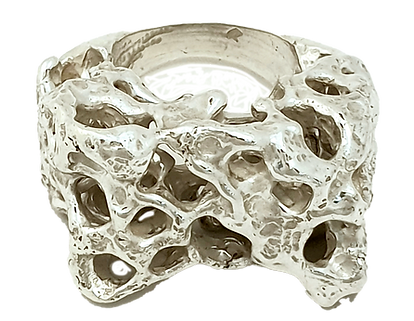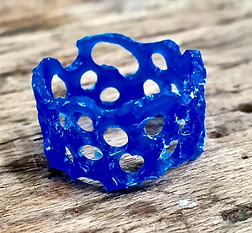Dundee University
First Class Honours
Talamh Jewellery
Partnerships Networks Connections
For this project we were to create our own fine jewellery designs that were to be made by us using fine metals and later sold under a collective brand of our making, which we named Talamh.
My personal collection within the Talamh jewellery range was inspired by natural erosion of rocks, small and large, in nature. The pieces in the collection complemented each other beautifully as other members took inspiration from plants, wood and brain scans.



I was interested by the shapes left on rocks from sand, wind and water. The complicated shapes but textured, smooth sharp lines fascinated me - how could something so solid looking could also appear sculptured?

In order to match our nature branding we decided the packaging would be natural looking.
Using thin wood boards instead of cardboard gave a luxury feel to the jewellery, as well as cut down on manufacturing.
We then used a laser to engrave the brand logo onto the packaging.
Manufacture Process



How did we make my collection?
Well, after much experimentation, we found wax vacuum casting to be the most effective technique.
Working with wax was a lot more fluid and malleable, allowing me to achieve the erosion aesthetic I was after.
Starting with wax, I carved out holes, grooves and structures just like sand and water would on a rock using various drill bits, sandpaper and compressed air.
I could then add a more smoothed texture over the jewellery by using a heat gun to melt the top layers. This created a smoothed finish and rounded edges, removing the tool marks.


Lost wax vacuum casting involves working from wax, then welding it onto a wax tree that is then covered in a ceramic mould.
From here, you melt the wax in an oven, which leaves an empty space which molten metal can be poured into, creating an exact replica of the wax tree out of metal. You can then cut out your work and clean it up.
Failed Manufacturing Technique
During this project I spent time exploring potential alternative manufacturing options, including. 3D scanning designs and 3D printing. I thought these techniques could help me to increase production and achieve more symmetry between the rings. However, there was limited time to explore the full capabilities and problem-solve the challenges of digitising the designs accurately, as well as improve printer quality on small detailed prints.




